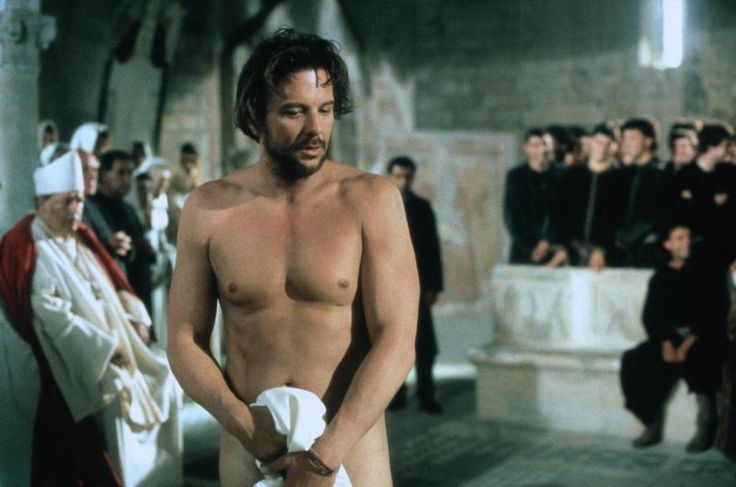The Flowers of St. Francis (1950)
The Italian title of Roberto Rossellini’s The Flowers of St. Francis is Francesco, giullare di Dio, “Francis, God’s Jester.” Yet in the pages of The Little Flowers, the one who is called the "jester of the Lord" is not Francis, but the saint’s disciple Brother Juniper. In this, Rossellini follows his source, focusing on Brother Juniper as well as Francis’s other followers as the film’s jesters or fools, trying as they do with charming naivete to stumble along in the footsteps of their master.
Caveat Spectator
Some mistreatment of a monk. Subtitles.It’s actually a bit of a shock, watching The Flowers, to realize that Francis himself is for once neither an eccentric nor a holy fool, but the straight man — a figure of Christlike wisdom indulgently shaking his head over the well-meaning foolishness of his disciples. An apt picture, perhaps, of all our best efforts in the spiritual life in the eyes of our Lord.
In keeping with the Italian neorealist precept of casting non-professional actors in suitable roles, Francis and his followers are played, appropriately, by the Franciscan friars of the Nocere Inferiore monastery in Rome. As portrayed by the friars, Francis’ followers are certainly foolish — but they are also joyful, and even materialistic modern viewers may be able to recognize here something that is lacking in our desacralized age.
At the same time, Rossellini doesn’t cater to contemporary sensibilities by reinventing Francis as a mere eccentric free spirit, a medieval flower child, such as we find in Zefferelli’s Brother Sun, Sister Moon. Francis remains challenging to modern audiences here, his childlike spirit joined to insistence on strict religious obligation and ultimately to zeal for evangelization.
All three of these principles converge with sublime perfection in the delightful climactic episode, drawn from the Little Flowers, in which Francis commands his followers "under holy obedience" to spin around "like children at play" until they collapse from dizziness, at which point they must strike out in whatever direction they are facing to preach the gospel.
As Rossellini himself has indicated, The Flowers of St. Francis is neither a complete biography of the saint nor a total portrait of Franciscan spirituality. Bookended between Francis’s return from Rome at the beginning and his sending out of the brothers to preach at the end, the episodic film makes no attempt to cover Francis’s early life and conversion, or his reception of the stigmata and his death.
Instead, The Flowers focuses, in Rossellini’s words, on "the merrier aspect of the Franciscan experience, on the playfulness, the ‘perfect delight,’ the freedom that the spirit finds in poverty, and in an absolute detachment from material things." In this spirit of Franciscan joy and detachment, Rossellini felt, was "the most accomplished form of the Christian ideal," and in his film he tried to capture what he called "the perfume of the most primitive Franciscanism" as preserved in The Little Flowers.
The fruit of his efforts is a beautifully simple little film that is as much a tribute to the spirit of humane curiosity in which the film itself was made as to the heritage of spirituality that is its transcendent theme.
Cinephiles, Catholic and non-Catholic, rejoice! Rossellini’s masterpiece The Flowers of St. Francis, until now almost totally inaccessible, is finally available on DVD in North America (Region 1) from the Criterion Collection as well as the UK (Region 2) from the Masters of Cinema series.
In the US, The Flowers of St. Francis was edited for its 1952 release, with Rossellini’s chapter-like intertitles and a couple of scenes removed and a historical prologue that had been removed from the original Italian edition reintroduced.
This prologue, called the "Giotto prologue" after the thirteenth-century fresco artist whose artwork it features, may or may not have been directed by Rossellini (Rossellini refers to the prologue in his statement on the film, made before the prologue was removed), and is intended to "introduce the public to the spirit" of the Little Flowers.
The new DVD editions feature the original 1950 Italian cut of the film, moving the Giotto prologue to the extras section and including Rossellini’s intertitles. Other extras in Criterion’s US DVD include interviews with film critic and priest Fr. Virgilio Fantuzzi and actress Isabella Rossellini, daughter of Rossellini and Ingrid Bergman.
I’m lucky enough to have seen the US edition previously, and, watching the Criterion DVD, I was struck at how the Italian edition, while it lacks the Giotto prologue’s "introduction to the spirit" of the Little Flowers, is overall more evocative of that spirit, with its vignettes prefaced by intertitles like "How Brother Juniper returned naked to St. Mary of the Angels where the brothers had finished building their hut" or "Of the wonderful meeting of St. Claire and St. Francis at St. Mary of the Angels."
Among key scenes cut from the US version but included here are the famous episode of St. Francis meeting the leper and the discussion with Brother Leo about "perfect joy."
Related

Francesco (1989)
How is it, then, that Cavani succeeds in making Francesco neither an attractive hero of secular virtues nor an off-putting champion of spiritual ones? How does she come to make her protagonist off-putting without being otherworldly, earthbound without being attractive?
Recent
- Benoit Blanc goes to church: Mysteries and faith in Wake Up Dead Man
- Are there too many Jesus movies?
- Antidote to the digital revolution: Carlo Acutis: Roadmap to Reality
- “Not I, But God”: Interview with Carlo Acutis: Roadmap to Reality director Tim Moriarty
- Gunn’s Superman is silly and sincere, and that’s good. It could be smarter.
Home Video
Copyright © 2000– Steven D. Greydanus. All rights reserved.